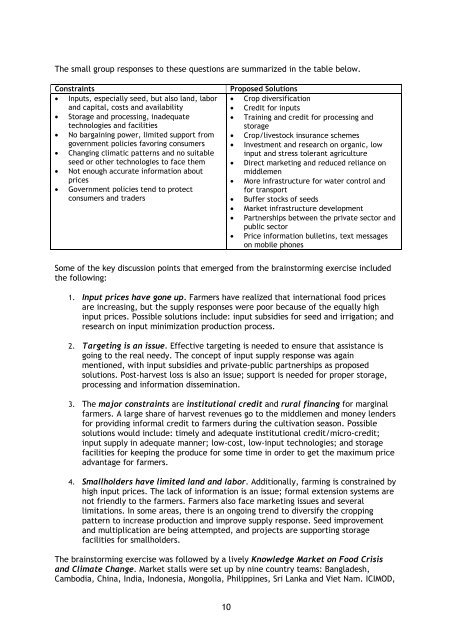Workshop Report pdf - IFAD
Workshop Report pdf - IFAD
Workshop Report pdf - IFAD
You also want an ePaper? Increase the reach of your titles
YUMPU automatically turns print PDFs into web optimized ePapers that Google loves.
The small group responses to these questions are summarized in the table below.<br />
Constraints<br />
• Inputs, especially seed, but also land, labor<br />
and capital, costs and availability<br />
• Storage and processing, inadequate<br />
technologies and facilities<br />
• No bargaining power, limited support from<br />
government policies favoring consumers<br />
• Changing climatic patterns and no suitable<br />
seed or other technologies to face them<br />
• Not enough accurate information about<br />
prices<br />
• Government policies tend to protect<br />
consumers and traders<br />
Proposed Solutions<br />
• Crop diversification<br />
• Credit for inputs<br />
• Training and credit for processing and<br />
storage<br />
• Crop/livestock insurance schemes<br />
• Investment and research on organic, low<br />
input and stress tolerant agriculture<br />
• Direct marketing and reduced reliance on<br />
middlemen<br />
• More infrastructure for water control and<br />
for transport<br />
• Buffer stocks of seeds<br />
• Market infrastructure development<br />
• Partnerships between the private sector and<br />
public sector<br />
• Price information bulletins, text messages<br />
on mobile phones<br />
Some of the key discussion points that emerged from the brainstorming exercise included<br />
the following:<br />
1. Input prices have gone up. Farmers have realized that international food prices<br />
are increasing, but the supply responses were poor because of the equally high<br />
input prices. Possible solutions include: input subsidies for seed and irrigation; and<br />
research on input minimization production process.<br />
2. Targeting is an issue. Effective targeting is needed to ensure that assistance is<br />
going to the real needy. The concept of input supply response was again<br />
mentioned, with input subsidies and private-public partnerships as proposed<br />
solutions. Post-harvest loss is also an issue; support is needed for proper storage,<br />
processing and information dissemination.<br />
3. The major constraints are institutional credit and rural financing for marginal<br />
farmers. A large share of harvest revenues go to the middlemen and money lenders<br />
for providing informal credit to farmers during the cultivation season. Possible<br />
solutions would include: timely and adequate institutional credit/micro-credit;<br />
input supply in adequate manner; low-cost, low-input technologies; and storage<br />
facilities for keeping the produce for some time in order to get the maximum price<br />
advantage for farmers.<br />
4. Smallholders have limited land and labor. Additionally, farming is constrained by<br />
high input prices. The lack of information is an issue; formal extension systems are<br />
not friendly to the farmers. Farmers also face marketing issues and several<br />
limitations. In some areas, there is an ongoing trend to diversify the cropping<br />
pattern to increase production and improve supply response. Seed improvement<br />
and multiplication are being attempted, and projects are supporting storage<br />
facilities for smallholders.<br />
The brainstorming exercise was followed by a lively Knowledge Market on Food Crisis<br />
and Climate Change. Market stalls were set up by nine country teams: Bangladesh,<br />
Cambodia, China, India, Indonesia, Mongolia, Philippines, Sri Lanka and Viet Nam. ICIMOD,<br />
10
















